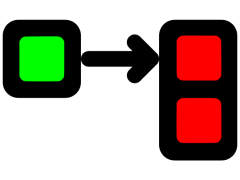EasyNetQ: Big Breaking Changes in the Advanced Bus
Join the DZone community and get the full member experience.
Join For FreeEasyNetQ is my little, easy to use, client API for RabbitMQ. It’s been doing really well recently. As I write this, it has 24,653 downloads on NuGet, making it by far the most popular high-level RabbitMQ API.

The goal of EasyNetQ is to make working with RabbitMQ as easy as possible. I wanted junior developers to be able to use basic messaging patterns out-of-the-box with just a few lines of code and have EasyNetQ do all the heavy lifting: exchange-binding-queue configuration, error management, connection management, serialization, thread handling; all the things that make working against the low level AMQP C# API, provided by RabbitMQ, such a steep learning curve.
To meet this goal, EasyNetQ has to be a very opinionated library. It has a set way of configuring exchanges, bindings and queues based on the .NET type of your messages. However, right from the first release, many users said that they liked the connection management, thread handling, and error management, but wanted to be able to set up their own broker topology. To support this, we introduced the advanced API, an idea stolen shamelessly from Ayende’s RavenDB client.
You access the advanced bus (IAdvancedBus) via the Advanced property on IBus:
var advancedBus = RabbitHutch.CreateBus("host=localhost").Advanced;Sometimes something can seem like a good idea at the time, and then later you think, “WTF! Why on earth did I do that?” It happens to me all the time. I thought it would be cool if I created the exchange-binding-queue topology and then passed it to the publish and subscribe methods, which would then internally declare the exchanges and queues and do the binding. I implemented a tasty little visitor pattern in my ITopologyVisitor. I optimized for my own programming pleasure, rather than an a simple, obvious, easy-to-understand API.
I realized a while ago that a more straightforward set of declares on IAdvancedBus would be a far more obvious and intentional design. To this end, I’ve refactored the advanced bus to separate declares from publishing and consuming. I just pushed the changes to NuGet and have also updated the Advanced Bus documentation. Note that these are breaking changes, so please be careful if you are upgrading to the latest version, 0.12, and upwards.
Here is a taste of how it works:
Declare a queue, exchange and binding, and consume raw message bytes:
var advancedBus = RabbitHutch.CreateBus("host=localhost").Advanced;
var queue = advancedBus.QueueDeclare("my_queue");
var exchange = advancedBus.ExchangeDeclare("my_exchange", ExchangeType.Direct);
advancedBus.Bind(exchange, queue, "routing_key");
advancedBus.Consume(queue, (body, properties, info) => Task.Factory.StartNew(() =>
{
var message = Encoding.UTF8.GetString(body);
Console.Out.WriteLine("Got message: '{0}'", message);
}));Note that I’ve renamed ‘Subscribe’ to ‘Consume’ to better reflect the underlying AMQP method.
Declare an exchange and publish a message:
var advancedBus = RabbitHutch.CreateBus("host=localhost").Advanced;
var exchange = advancedBus.ExchangeDeclare("my_exchange", ExchangeType.Direct);
using (var channel = advancedBus.OpenPublishChannel())
{
var body = Encoding.UTF8.GetBytes("Hello World!");
channel.Publish(exchange, "routing_key", new MessageProperties(), body);
}You can also delete exchanges, queues and bindings:
var advancedBus = RabbitHutch.CreateBus("host=localhost").Advanced;
// declare some objects
var queue = advancedBus.QueueDeclare("my_queue");
var exchange = advancedBus.ExchangeDeclare("my_exchange", ExchangeType.Direct);
var binding = advancedBus.Bind(exchange, queue, "routing_key");
// and then delete them
advancedBus.BindingDelete(binding);
advancedBus.ExchangeDelete(exchange);
advancedBus.QueueDelete(queue);
advancedBus.Dispose();I think these changes make for a much better advanced API. Have a look at the documentation for the details.
Published at DZone with permission of Mike Hadlow, DZone MVB. See the original article here.
Opinions expressed by DZone contributors are their own.

Comments